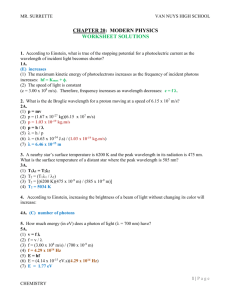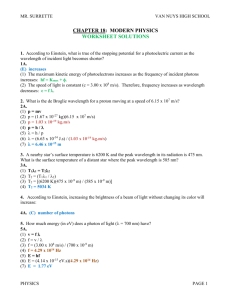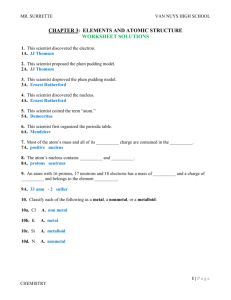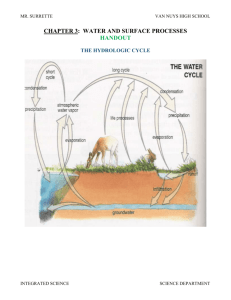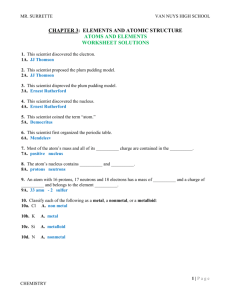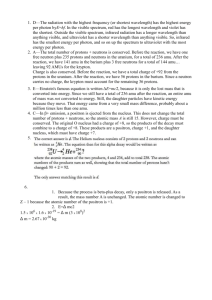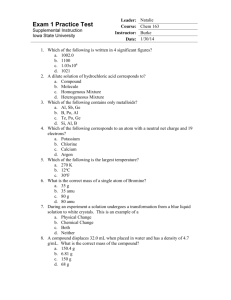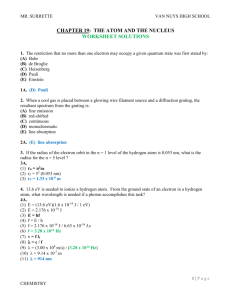Solutions_P17P18
advertisement
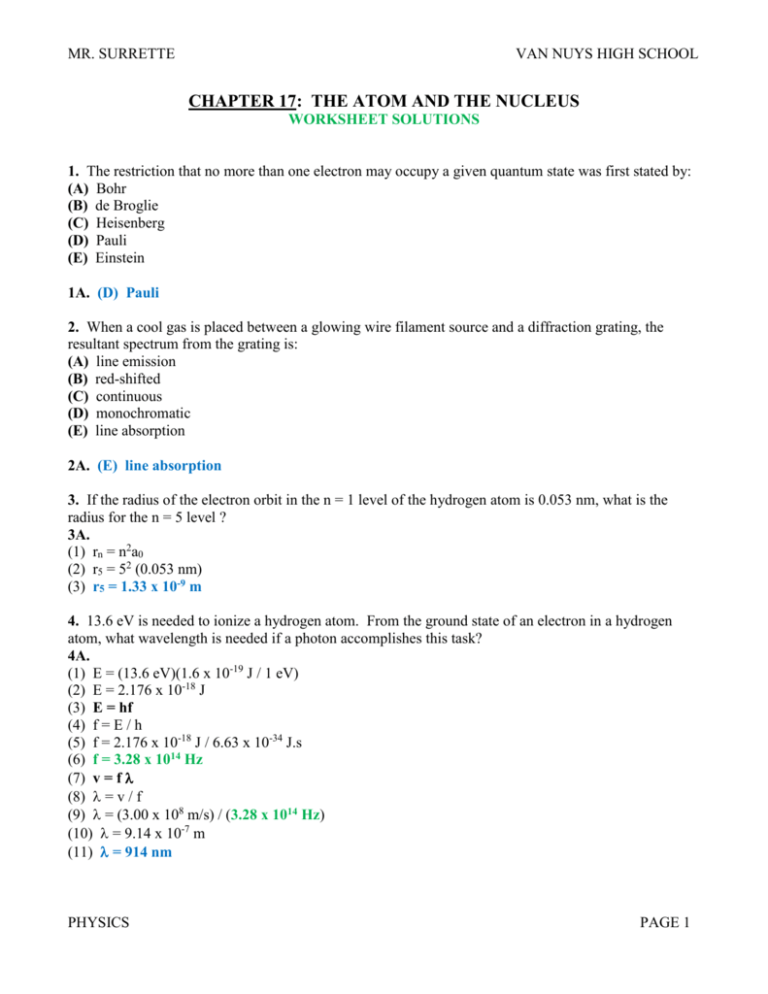
MR. SURRETTE VAN NUYS HIGH SCHOOL CHAPTER 17: THE ATOM AND THE NUCLEUS WORKSHEET SOLUTIONS 1. The restriction that no more than one electron may occupy a given quantum state was first stated by: (A) Bohr (B) de Broglie (C) Heisenberg (D) Pauli (E) Einstein 1A. (D) Pauli 2. When a cool gas is placed between a glowing wire filament source and a diffraction grating, the resultant spectrum from the grating is: (A) line emission (B) red-shifted (C) continuous (D) monochromatic (E) line absorption 2A. (E) line absorption 3. If the radius of the electron orbit in the n = 1 level of the hydrogen atom is 0.053 nm, what is the radius for the n = 5 level ? 3A. (1) rn = n2a0 (2) r5 = 52 (0.053 nm) (3) r5 = 1.33 x 10-9 m 4. 13.6 eV is needed to ionize a hydrogen atom. From the ground state of an electron in a hydrogen atom, what wavelength is needed if a photon accomplishes this task? 4A. (1) E = (13.6 eV)(1.6 x 10-19 J / 1 eV) (2) E = 2.176 x 10-18 J (3) E = hf (4) f = E / h (5) f = 2.176 x 10-18 J / 6.63 x 10-34 J.s (6) f = 3.28 x 1014 Hz (7) v = f (8) = v / f (9) = (3.00 x 108 m/s) / (3.28 x 1014 Hz) (10) = 9.14 x 10-7 m (11) = 914 nm PHYSICS PAGE 1 MR. SURRETTE VAN NUYS HIGH SCHOOL 5. When a glowing wire filament source is placed behind a diffraction grating, the resultant spectrum from the grating is: (A) line emission (B) line absorption (C) continuous (D) monochromatic (E) blue-shifted 5A. (A) line emission 6. A radioactive material initially has an activity of 1200 counts/sec. If six hours later it has an activity of 300 counts/sec, what is its half life? 6A. (1) 1200 600 300 (2) 2 half-lives have gone by, since each arrow represents one half-life. (3) Let x = one half-life. (4) Since the total time is 6 hours: 2x = 6 hours (5) x = 3 hours 7. 88Ra-226 decays to 86Rn-222 by emitting what type of particle: (A) beta (B) proton (C) gamma (D) positron (E) alpha 7A. A= number of nucleons Z = number of protons (1) Parent particle: A = 226 Z = 88 (2) Daughter particle: A = 222 Z = 86 (3) A = 4 Z = 2 (4) (E) alpha particle 8. How does the daughter nucleus differ from the parent in the beta emission process? (A) atomic mass increases by one (B) atomic number increases by two (C) atomic number increases by one (D) atomic mass decreases by two (E) atomic charge increases by two 8A. (C) atomic number increases by one PHYSICS PAGE 2 MR. SURRETTE VAN NUYS HIGH SCHOOL 9. What is the Q-value when one hydrogen atom and one neutron combine to form a deuterium atom? (hydrogen 1.007825 u, neutron 1.009665 u, deuterium 2.014100 u) 9A. Let mB = “mass before reaction” Let mA = “mass after reaction” (1) mB = 1 H + 1 n (2) mB = 1.007825 u + 1.009665 u (3) mB = 2.01749 u (4) mA = 2H (5) mA = 2.014100 u (6) m = mB - mA (7) m = 2.01749 u – 2.014100 u (8) m = 0.00339 u (9) E = mc2 (10) E = (m)c2 (11) E = (0.00339 u)(931.5 MeV / 1u) (12) E = 3.16 MeV 10. If C-12 has 6 neutrons, how many neutrons are in C-14? 10A. (1) A1 = Z + N1 (2) Z = A1 – N1 (3) Z = 12 – 6 (4) Z = 6 (number of protons in C) (5) A2 = Z + N2 (6) N2 = A2 – Z (7) N2 = 14 – 6 (8) N2 = 8 (number of neutrons in C-14) 11. (A) (B) (C) (D) (E) What particle can be emitted when 15P-32 decays to 16S-32? alpha electron neutron gamma proton 11A. (B) since the number of nucleons remains constant, and the atomic number increases by one, this is a beta reaction. 12. The binding energy of a nucleus is (A) the energy needed to remove one of the electrons (B) the average energy of any nucleon (C) the energy needed to separate all the nucleons (D) the mass of the nucleus times c2 (E) the mass of the nucleus divided by c2 2A. (C) the energy needed to separate all the nucleons. PHYSICS PAGE 3 MR. SURRETTE 13. (A) (B) (C) (D) (E) VAN NUYS HIGH SCHOOL If controlled fusion becomes feasible, which would be the main source of fuel: corn oil air coal water petroleum 13A. (D) water 14. (A) (B) (C) (D) (E) Nuclear fusion involves combining the nuclei of: low atomic numbers metals non-metals noble gases high atomic numbers 14A. (A) low atomic numbers 15. (A) (B) (C) (D) (E) The function of the moderator material in a nuclear fission reactor is to: absorb neutrons create new neutrons accelerate neutrons decelerate neutrons destroy neutrons 15A. (D) decelerate neutrons 16. The energy released per fission event of U-235 is 208 MeV. This reaction is 30% efficient. Approximately how many fission events occur in one second to provide the 2.00 kW electrical power needs of a typical home? (1 eV = 1.6 x 10-19 J) 16A. (1) Energy = (0.30)(208 x 106 eV) (2) Energy = 6.24 x 107 eV (3) 6.24 x 107 eV (1.6 x 10-19 J / 1 eV) (4) Energy = 9.984 x 10-12 J (5) Rate = (2000 J / 1 sec)(1 event / 9.984 x 10-12 J) (6) Rate = 2.00 x 1014 events / sec PHYSICS PAGE 4 MR. SURRETTE 17. (A) (B) (C) (D) (E) VAN NUYS HIGH SCHOOL Cadmium control rods used in a nuclear fission reactor serve what purpose: absorb neutrons create new neutrons accelerate neutrons decelerate neutrons destroy neutrons 17A. (A) absorb neutrons 18. A proton and a neutron combine in a fusion process to form a stable deuterium nucleus. Which of the following statements best applies to the mass of the deuterium nucleus? (A) less than the sum of the proton and neutron masses (B) equal to the sum of the proton and neutron masses (C) greater than the sum of the proton and neutron masses (D) equal to twice the proton mass (E) equal to half the proton mass 18A. (A) less than the sum of the proton and neutron masses. PHYSICS PAGE 5 MR. SURRETTE VAN NUYS HIGH SCHOOL CHAPTER 18: MODERN PHYSICS WORKSHEET SOLUTIONS 1. According to Einstein, what is true of the stopping potential for a photoelectric current as the wavelength of incident light becomes shorter? 1A. (E) increases (1) The maximum kinetic energy of photoelectrons increases as the frequency of incident photons increases: hf = Kmax + . (2) The speed of light is constant (c = 3.00 x 108 m/s). Therefore, frequency increases as wavelength decreases: c = f . 2. What is the de Broglie wavelength for a proton moving at a speed of 6.15 x 107 m/s? 2A. (1) p = mv (2) p = (1.67 x 10-27 kg)(6.15 x 107 m/s) (3) p = 1.03 x 10-19 kg.m/s (4) p = h / (5) = h / p (6) = (6.63 x 10-34 J.s) / (1.03 x 10-19 kg.m/s) (7) = 6.46 x 10-15 m 3. A nearby star’s surface temperature is 6200 K and the peak wavelength in its radiation is 475 nm. What is the surface temperature of a distant star where the peak wavelength is 585 nm? 3A. (1) T11 = T22 (2) T2 = (T11 / 2) (3) T2 = [(6200 K)(475 x 10-9 m) / (585 x 10-9 m)] (4) T2 = 5034 K 4. According to Einstein, increasing the brightness of a beam of light without changing its color will increase: 4A. (C) number of photons 5. How much energy (in eV) does a photon of light ( = 700 nm) have? 5A. (1) v = f (2) f = v / (3) f = (3.00 x 108 m/s) / (700 x 10-9 m) (4) f = 4.29 x 1014 Hz (5) E = hf (6) E = (4.14 x 10-15 eV.s)(4.29 x 1014 Hz) (7) E = 1.77 eV PHYSICS PAGE 6 MR. SURRETTE VAN NUYS HIGH SCHOOL 6. Light of wavelength 415 nm is incident onto the surface of a metal whose work function is 1.85 eV. 6a. What is the frequency of the light wave in petahertz? A. (1) v = f f = v / (3) f = (3.00 x 108 m/s) / 415 x 10-9 m (4) f = 7.23 x 1014 Hz (5) f = 0.723 PHz 6b. A. (1) (2) (3) Compute the photon energy in eV. E = hf E = (4.14 x 10-15 eV.s)(7.23 x 1014 Hz) E = 2.99 eV 6c. Will these photons eject electrons from the metal’s surface? A. Yes, the photon energy (2.99 eV) is greater than the minimum energy needed (1.85 eV), the work function(). 6d. A. (1) (2) (3) (4) What is the predicted value of the maximum kinetic energy of the photoelectrons? E = Kmax + Kmax = E – Kmax = 2.99 eV – 1.85 eV Kmax = 1.22 eV 6e. Would photons of wavelength 830 nm produce photoelectrons? A. No. Doubling the wavelength halves the photon energy: (1) v = f (2) f = v / (3) f = (3.00 x 108 m/s) / (830 x 10-9 m) (4) f = 3.61 x 1014 Hz (5) E = hf (6) E = (4.14 x 10-15 eV.s)(3.61 x 1014 Hz) (7) E = 1.50 eV Since the work function ( is 1.85 eV, photons of 1.50 eV will not release photoelectrons. PHYSICS PAGE 7 MR. SURRETTE VAN NUYS HIGH SCHOOL 7. If a hydrogen atom in the state n = 4 makes a transition to the state n = 2, what is the energy of the photon that is emitted? 7A. (1) E = (13.6 eV / (n2)2) – (13.6 eV / (n4)2) (2) E = (13.6 eV / 22) – (13.6 eV / 42) (3) E = 3.4 eV – 0.85 eV (4) E = 2.55 eV 8. The observed relativistic length of a super rocket moving by the observer at 0.875 c will be what factor times that of the measured rocket length at rest? 8A. (1) L = L’ [1 – v2/c2]1/2 (2) L = L’ [1 – (0.875 c)2/(1.0 c)2]1/2 (3) L = L’ (0.125)1/2 (4) L = (0.35) L’ (5) factor = 0.35 9. How fast would a rocket have to move past a ground observer if he observed a 12% length contraction in the rocket length? 9A. (1) L = L’ [1 – v2/c2]1/2 (2) (0.88 L’) = L’ [1 – v2/c2]1/2 (3) (0.88 L’) = L’ [1 – v2/c2]1/2 (4) 0.88 = (1 – v2/c2)1/2 (5) (0.88)2 = 1 – v2/c2 (6) - v2/c2 = (0.88)2 -1 (7) v2/c2 = 1 - (0.88)2 (8) v2/c2 = 0.0226 (9) v2 = (0.0226)(c2) (10) v2 = (0.0226)(3.00 x 108 m/s)2 (11) v = [(0.0226)(3.00 x 108 m/s)2]1/2 (12) v = 1.42 x 108 m/s 10. An unknown particle in an accelerator moving at a speed of 2.85 x 108 m/s has a measured relativistic mass of 3.2 x 10-26 kg. What is its rest mass? 10A. (1) m = mo / [1 – (v2/c2)]1/2 (2) mo = (m)[1 – (v2/c2)]1/2 (3) mo = (3.2 x 10-26 kg)[1 – (2.85 x 108 m/s)2/(3.00 x 108 m/s)2]1/2 (4) mo = 1.6 x 10-27 kg PHYSICS PAGE 8 MR. SURRETTE VAN NUYS HIGH SCHOOL 11. An astronaut whose heart rate on Earth is 70 per minute increases his velocity to v = 0.980 c. What is his heart rate now as measured by an Earth observer? 11A. (1) t = (t)’ / [1 – (v2/c2)]1/2 (2) t =(t)’ / [1 - (0.980 c)2/(1.00 c)2]1/2 (3) t = (t)’ / 0.0199 (4) t’ = (0.0199) t (5) t’ = (0.0199)(70 per minute) (6) t’ = 13.9 per minute 12. The short lifetime of muons created in the upper atmosphere of the Earth would not allow them to reach the surface of the Earth unless their lifetime increased by time dilation. From the reference system of the muons, the muons can reach the surface of the Earth because: 12A. (D) length contraction decreases the distance to the Earth PHYSICS PAGE 9 MR. SURRETTE VAN NUYS HIGH SCHOOL CHAPTERS 17 - 18: THE ATOM, NUCLEUS, AND MODERN PHYSICS QUIZ SOLUTIONS 1. The restriction that no more than one electron may occupy a given quantum state was first stated by: 1A. Pauli 2. The equation E = hf was first formulated by: 2A. Planck 3. If the radius of the electron orbit in the n = 1 level of the hydrogen atom is 0.053 nm, what is the radius for the n = 2 level ? 3A. (1) rn = n2a0 (2) r3 = 22 (0.053 nm) (3) r3 = 2.12 x 10-10 m 4. A vapor lamp gives off light. Determine the wavelength of light given off if the energy difference Ef – Ei = 2.10 eV. 4A. (1) E = (2.10 eV)(1.6 x 10-19 J / 1 eV) (2) E = 3.36 x 10-19 J (3) E = hf (4) f = E / h (5) f = 3.36 x 10-19 J / 6.63 x 10-34 J.s (6) f = 5.07 x 10-14 Hz (7) v = f (8) = v / f (9) = (3 x 108 m/s) / (5.07 x 10-14 Hz) (10) = 592 nm 5. 12.1 eV is needed to ionize an unknown atom. From the ground state of an electron in a hydrogen atom, what wavelength is needed if a photon accomplishes this task? 5A. (1) E = (12.1 eV)(1.6 x 10-19 J / 1 eV) (2) E = 1.94 x 10-18 J (3) E = hf (4) f = E / h (5) f = 1.94 x 10-18 J / 6.63 x 10-34 J.s (6) f = 2.92 x 1015 Hz (7) v = f (8) = v / f (9) = (3 x 108 m/s) / (2.92 x 1015 Hz) (10) = 103 nm PHYSICS PAGE 10 MR. SURRETTE VAN NUYS HIGH SCHOOL 6. A radioactive material initially has an activity of 1200 counts/sec. If eight hours later it has an activity of 200 counts/sec, what is its half life? 6A. (1) 1200 600 300 (2) 3 half-lives have gone by, since each arrow represents one half-life. (3) Let x = one half-life (4) The total time is 8 hours (5) 3x = 8 hours (6) x = 8/3 = 2.67 hours 7. If there are 129 neutrons in X-205, how many neutrons are in X-208? 7A. (1) A1 = Z + N1 (2) Z = A1 – N1 (3) Z = 205 – 129 (4) Z = 76 (5) A2 = Z + N2 (6) N2 = A2 – Z (7) N2 = 208 – 76 (8) N2 = 132 8. What is the Q-value for the reaction 9Be + 12C + n? (m = 4.0026 amu, mBe = 9.01218 amu, mc = 12.0000 amu, mn = 1.008665 amu, and c2 = 931 MeV/amu) 8A. (1) mB = mBe + m mamu4.0026 amu (3) mB = 13.01478 amu (4) mA = mc + mn (5) mA = 12.0000 amu + 1.008665 amu (6) mA = 13.008665 amu (7) m = mB – mA (8) m = 0.006115 amu (9) E = mc2 (10) E = (m)c2 (11) E = (0.006115 amu)(931 MeV/amu) (12) E = 5.69 MeV = Q-value 9. The energy released per fission event of U-235 is 195 MeV. This reaction is 37% efficient. Approximately how many fission events occur in one second to provide the 1.99 kW electrical power needs of a typical home? (1 eV = 1.6 x 10-19 J) PHYSICS PAGE 11 MR. SURRETTE VAN NUYS HIGH SCHOOL 9A. (1) Energy = (0.37)(195 x 106 eV) (2) Energy = 7.22 x 107 eV (3) 7.22 x 107 eV (1.6 x 10-19 J / 1 eV) (4) Energy = 1.15 x 10-11 J (5) Rate = (1990 J / 1 sec)(1 event / 1.15 x 10-11 J) (6) Rate = 1.73 x 1014 events / sec 10. How fast would a rocket have to move past a ground observer if he observed a 17% length contraction in the rocket length? 10A. (1) L = L’ [1 – v2/c2]1/2 (2) (0.83 L’) = L’ [1 – v2/c2]1/2 (3) (0.83 L’) = L’ [1 – v2/c2]1/2 (4) 0.83 = (1 – v2/c2)1/2 (5) (0.83)2 = 1 – v2/c2 (6) - v2/c2 = (0.83)2 -1 (7) v2/c2 = 1 - (0.83)2 (8) v2/c2 = 0.311 (9) v2 = (0.311)(c2) (10) v2 = (0.311)(3 x108 m/s)2 (11) v = [(0.311)(3x108 m/s)2]1/2 (12) v = 1.67 x 108 m/s 11. Light of wavelength 489 nm is incident on a metallic surface with a resultant photoelectric stopping potential (work function against an electron) of 0.8 V. What is the maximum kinetic energy of the emitted electrons? 11A. (1) v = f (2) c = f (3) f = c / (4) f = (3 x 108 m/s) / (489 x 10-9 m) (5) f = 6.13 x 1014 Hz (6) Kmax = hf – (7) hf = (6.63 x 10-34 J.s)(6.13 x 1014 Hz) (8) hf = 4.07 x 10-19 J (9) hf = 4.07 x 10-19 J (1 eV / 1.6 x 10-19 J) (10) hf = 2.54 eV (11) Kmax = 2.54 eV – 0.8 eV (12) Kmax = 1.74 eV PHYSICS PAGE 12 MR. SURRETTE VAN NUYS HIGH SCHOOL 12. An astronaut whose heart rate on Earth is 58 per minute increases his velocity to v = 0.899c. What is his heart rate now as measured by an Earth observer? 12A. (1) t = (t)’ / [1 – (v2/c2)]1/2 (2) t =(t)’ / [1-(0.899c)2/(1.00c)2]1/2 (3) t = (t)’ / 0.438 (4) t’ = 0.438 t (5) t’ = (0.438)(58 per minute) (6) t’ = 25.4 per minute 13. What is the wavelength (in nanometers) of a monochromatic light beam where the photon energy is 2.89 eV? 13A. (1) E= (2.89 eV) (1.6 x 10-19 J / eV) = 4.62 x 10-19 J (2) E = hf (3) f = E / h (4) f = (4.62 x 10-19 J) / (6.63 x 10-34 J.s) (5) f = 6.97 x 1014 Hz (6) v = f (7) c = f (8) = c / f (9) = (3 x 108 m/s) / (6.97 x 1014 Hz) (10) = 4.30 x 10-7 m (11) = 430 nm 14. When one ton of an explosive detonates, approximately 4.27 x 1010 J of energy is released. How much mass does this represent in a mass-to-energy ratio? 14A. (1) E = mc2 (2) m = E / c2 (3) m = (4.27 x 1010 J) / (3 x 108 m/s)2 (4) m = 4.74 x 10-7 kg 15. What is the de Broglie wavelength for a particle (m = 3.21 x 10-26 kg) moving at a speed of 7.12 x 107 m/s? 15A. (1) p = mv (2) p = (3.21 x 10-26 kg)(7.12 x 107 m/s) (3) p = 2.29 x 10-18 kg.m/s (4) h = p (5) = h / p (6) = (6.63 x 10-34 J.s) / (2.29 x 10-18 kg.m/s) (7) = 2.90 x 10-16 m PHYSICS PAGE 13
